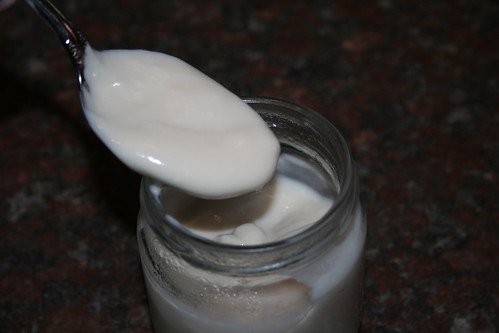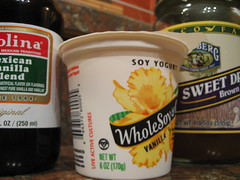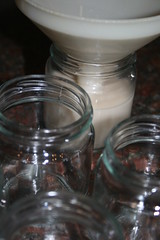
And now for something completely different. I figure that if you're the kind of person to make your own soy milk, you might also be the kind of person to make your own soy yogurt. In fact, if you're like me, you have the yogurt machine (which is really just an incubator that holds things at 110 degrees Fahrenheit) but are not sure what to do next.
I purchased my yogurt machine last year, but the instructions were completely dairy-centric and I found that dairy-to-soy substitutions (with a little sugar added to compensate for the absence of lactose) just didn't work. Internet searches for recipes were more or less fruitless. So I had to start from scratch. Now that I've finally perfected my recipe, I will post it here in the hopes that someone in the same position I was in last year will be able to find my formulation and save a lot of time.
You'll still have to tweak this recipe to get the yogurt to your liking. Adjust the sugar if it's too sweet or not sweet enough. Ferment it longer if it's not tart enough, or for less time if it's too tart. But I think you will find this to be a nice starter recipe.
Out-of-the-ordinary tools you will need to make your own yogurt:
a yogurt maker
a candy thermometer
First, shake a
13.5 oz. can of coconut milk
and open it, then pour the milk into a measuring cup. Add
2 1/4 cups unsweetened soy milk (cool or at room temperature)
to bring the total liquid to four cups.
NB: I use full-fat coconut milk, not lite. The brand I buy lists guar gum as an ingredient, which may or may not affect the yogurt's ability to thicken and set.
Pour most of the soy-coconut mixture into a pot, reserving 1/4 to 1/2 a cup. Add
1/4 cup corn starch
to the reserved liquid and whisk vigorously until the corn starch is dissolved.
Into the pot, stir
the corn starch/soy milk/coconut milk mixture
1/4 cup sugar
1/4 cup brown rice syrup

Over medium heat, whisk the contents of the pot more or less constantly, until the liquid is bubbling and has been thickened by the corn starch.
When the liquid is thickened, turn off the heat. Use the thermometer to monitor its temperature. When it reaches 110 degrees Fahrenheit, add
2 Tablespoons vanilla
5 Tablespoons vanilla soy yogurt
DO NOT add the yogurt when the temperature is above 110 degrees Fahrenheit!

NB: I used to use Whole Soy vanilla, but have been boycotting them since I purchased some defective yogurt. It tasted overly sweet, barely tart at all, and sure enough did not work as a starter for my own yogurt, meaning that it didn't have live cultures in it. When I wrote to them asking if there were any known problems with that batch, I never received a reply. I was miffed, so since then I've been using other soy yogurts. Make sure that the brand you use contains "live cultures."
I have also found that different brands have different concentrations of live cultures, which means if you switch to a different brand you might have to adjust incubation time to achieve desired level of tartness. For instance, WholeSoy took about 10-12 hours to ferment, while Silk took about 14 hours.
Using a whisk, incorporate the vanilla and store-bought soy yogurt thoroughly. Now comes the annoying part: pouring the yogurt into the jars. I use a funnel and a ladle. I try not to spill. It's annoying.

Pop the jars into the yogurt maker and set the timer for 10 hours. (The person I live with likes super-tart yogurt that has been left for 12 hours. So obviously this is part of the recipe that you'll need to tweak for yourself.) After the hours have elapsed, remove the jars from the machine, screw the lids on top, and refrigerate. If you find that the yogurt is not to your liking and you need to tweak the recipe, I suggest pouring the sub-par yogurt into a fruit smoothie. This is how I dealt with so many test batches of yogurt!
So what exactly is yogurt, anyway? Simply put, what you are doing here is taking some soy milk, throwing bacteria in it, and leaving it at 110 degrees Fahrenheit for hours on end, allowing the bacteria to proliferate. Appetizing, eh? Don't worry, these bacteria are beneficial. They come from the store-bought yogurt; you can also buy powdered yogurt starter, but many of these contain milk products. Use vegan soy yogurt as a starter if you want to make vegan yogurt.
Two important microorganisms that make up the yogurt are Streptococcus thermophilus and Lactobacillus delbrueckii bulgaricus, both of which produce lactic acid. When the yogurt is held at 110 degrees Fahrenheit, the conditions are ideal for bacteria to replicate, and that is what they do. S. thermophilus eats sugar and produces acid as a byproduct. So does L. d. bulgaricus, which also plays more of a role in the yogurt's flavor and aroma. Eventually, the lactic acid produced by the bacteria decreases the pH of the yogurt so much that other microorganisms are unable to survive. (So if you accidentally contaminate your yogurt with any other bacteria, it will probably be killed by the acidic environment. This is not an excuse to relax your kitchen-hygiene standards, however.)
Because soy milk and coconut milk don't contain lactose, you have to add sugar so the bacteria have food to eat. Additionally, the reason you must wait to add the store-bought yogurt until the temperature has dropped to 110 degrees Fahrenheit is because the bacteria will not be able to survive in temperatures that are much higher than that.
When you are popping the yogurt jars in the maker, should they make an actual popping sound?
ReplyDeleteI hope this isn't a too silly of a question but does this mean if I want to make Coconut Milk Yogurt I could theoretically use Soy Yogurt as a starter? Do the same bacteria colonize both types of yogurts?
ReplyDeletePerhaps it's the same bacteria in dairy and non dairy yogurts... I'm not sure.
I want to have just coconut milk yogurt and can't find any for a starter so...
Thanks for your help.
Ron
Hi Ron,
ReplyDeleteYou should be able to use any yogurt as a starter as long as it has "live cultures." The term "live cultures" refers to certain bacteria, and these types of bacteria are used in all yogurts. The bacteria eat sugar and produce lactic acid as a byproduct, which gives the yogurt its tart flavor.
As you can see from the recipe, I use a combination of coconut milk and soy milk to make my yogurt. I've never tried to make yogurt from only coconut milk, but it should work on the same principle: put the live cultures into the milk, along with some sugar.
Where I live, there is coconut yogurt you can buy at the store. Check out the packaging and make sure it has "live cultures" in it. If it does, it should work as a starter, which would enable you to have coconut yogurt with no soy.
I hope this is helpful. Feel free to ask any other questions. Sorry if this is a little incoherent; there was just an attempted political assassination where I live and I am upset.
But yes, you could use soy yogurt as a starter for coconut yogurt. You should also be able to use coconut yogurt as a starter. As long as the starter you use contains "live cultures" it should work, because they are the same bacteria species.
ReplyDeleteAnna, thanks so much when you've got such a terrible thing on your mind. I do hope things will get better.
ReplyDeleteYes, the bacterias in most of the yogurts look the same so I'm hoping I can do the straight coconut milk thing. I'll let you know.
Stay well.
Have you tried to make tempe gembus? It's fermeting okara to make a tempeh.
ReplyDeleteVeg Lab Rat: No, I haven't tried that, but I have heard of it. I should try to find a recipe, because it sounds pretty interesting. I remember years ago, when I started trying to make my own tofu, I would read here and there about ordering starter kits to make your own tempeh -- since I'm not a big fan of having to mail order my food, I never looked into it, but maybe this would be worth overcoming my aversion!
ReplyDeleteI tried making soy yogurt years ago and gave up after one try. Thanks for sharing!
ReplyDeleteThank you for sharing this recipe. I am going to try it this weekend. It looks like you may have the same yogurt maker as I do--Euro Cuisine, with the seven little glass jars. If you want to make a large bowl of yogurt as opposed to the (annoying) jars, try using the Pyrex 7 cup glass bowl.
ReplyDeletethis is the best blog i have stumbled upon in a long time. you rule.
ReplyDeleteHello! Do you close lids on the jars before putting them in yogurt machine? I have read a lot of different recipes, some of them suggest to seal lids, some - leave lids open, and some - to cover containers with cheesecloth. What is your advice about covering jars?
ReplyDeleteNo, I haven't put the lids on until I took them out of the yogurt maker.
DeleteThis comment has been removed by a blog administrator.
ReplyDelete